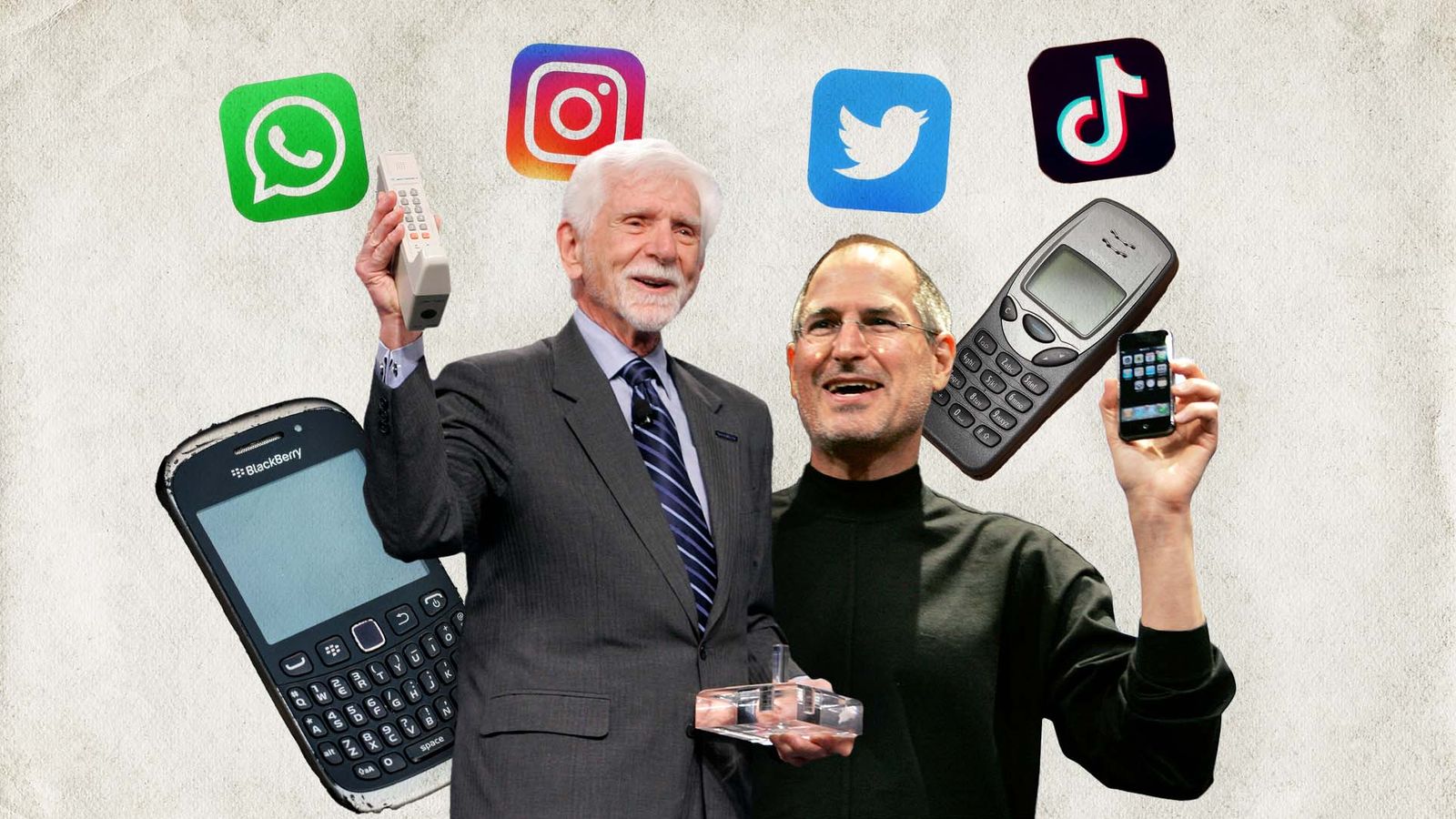Fifty years ago today, the first-ever mobile phone call was made.
Wielding a chunky handset that more closely resembles a clown shoe than a sleek modern smartphone, Motorola engineer Martin Cooper put his biceps to work and called his friend Joel Bell at rival company AT&T.
It was a proof of concept that has gone down in the annals of communications history alongside Alexander Bell’s invention of the telephone in 1876.
Here are 50 moments from the last 50 years that made our smartphones what they are today.
1. Dawn of 1G (1979)
You can’t get to 5G without one to four, and Japan introduced the first widely available analogue cellular system in 1979 – the catch was it didn’t work outside cars, as portable batteries weren’t powerful enough to go truly mobile.
2. The first mobile (1983)
The device used by Cooper in Manhattan on 3 April 1973 was a prototype of Motorola’s DynaTAC 8000X – the first commercially available mobile. It cost $3,995 ($12,000 today) and took 10 hours to charge for half an hour of call time.
3. UK’s first mobile phone call (1985)
Michael Harrison made the UK’s first mobile call from London’s Parliament Square on 1 January 1985 to his dad, Vodafone chairman Sir Ernest Harrison.
“Hi Dad, it’s Mike. This is the first-ever call made on a UK commercial mobile network,” he said, prompting raucous celebrations at Vodafone’s original HQ above an Indian restaurant in Newbury.
4. Flippin’ ‘eck! (1989)
The mobile phone went from potential doorstep to something that James Bond might have considered using with Motorola’s MicroTAC 9800X. The device itself was sexier than the name, as it introduced the flip phone format.
5. Mobiles go digital (1991)
Another extremely catchy name here – Global System for Mobile Communications (GSM). That was the European standard for what became known as 2G. It’s what we have to thank for SMS text messaging.
6. ‘Merry Christmas’ (1992)
That was the festive greeting in the first text message sent to a mobile on 3 December 1992. It was sent by British engineer Neil Papworth from a PC to an Orbitel 901 phone. Sky News interviewed him for the 25th anniversary – suitably, it was done by text.
Please use Chrome browser for a more accessible video player
7. Nokia brings UK up to speed (1992)
While Orbitel had introduced 2G by the time Nokia launched its 1011 phone, the Finnish firm’s effort was more pocketable and affordable, which helped bring the technology to Britons en masse.
8. A phone called Simon (1994)
Forget the iPhone, the first smartphone was Simon – a touchscreen device from IBM. It only worked in 15 US states and sold around 50,000 units, but in many ways was ahead of its time.
9. That ringtone… (1994)
Mariah Carey, Bon Jovi, Wet Wet Wet – just some of the artists in the charts in 1994. But there was one sound that defined the year, and that was the iconic Nokia ringtone that had an entire generation reaching for their pockets.
10. GSM gets an A (1995)
The founding of the GSM Association brought mobile operators into a trade body. It hosts Mobile World Congress, where many companies make big product announcements.
11. Slide into your SMS (1996)
We’ve had phones that flip and fold, but don’t forget ones that slide. The Nokia 8110, perhaps best known for appearing in The Matrix, had a hidden number pad revealed by sliding a cover off.
12. The first colour screen (1997)
A year before Nintendo‘s Game Boy got the colour treatment, the Siemens S10 was the first mobile to do it. Alas it couldn’t even show all the colours of the rainbow – only managing red, green, and blue.
13. Snake gets us gaming (1997)
The Game Boy would gain an unexpected rival when the Nokia 6110 arrived with Snake on board. Few games have been so synonymous with one device – it’s up there with Tetris on the Game Boy and Wii Sports on the… Wii.
14. Showing your style (1998)
We’ve long been used to phones coming in different colours and lots of case options, but it wasn’t always easy to customise them. It took until the Nokia 5110 for a manufacturer to try to cash in with interchangeable covers.
15. For the kids! (1999)
The Nokia 3210 is pure 90s nostalgia, and probably one of the most recognisable mobiles ever. It was thinner and lighter than the company’s previous phones, came with multiple games (including Snake, obvs), finally ditched the walkie-talkie-style external antenna, and could send picture messages.
Throw in a £150 launch price and the arrival of pay-as-you-go SIM cards and parents would soon find out that Tamagotchis just weren’t going to cut it any more.
16. Surf the web! (1999)
Not content with the 3210, Nokia also launched the 7110 model in 1999 – the first web phone. It could give you news, email, and – get this – even download new ringtones.
17. The first camera phone (2000)
You may not have heard of the Sharp J-SH04, given it was only available in Japan. But its place in mobile phone folklore has always been assured, as it was the first to be equipped with a camera.
18. Colour me impressed, Mr Bond (2001)
The first mobiles with full colour screens arrived in 2001, led by the Sony Ericsson T68I. It was also the first commercially available mobile to appear in the James Bond films, debuting in Die Another Day.
19. Camera phones go mainstream (2002)
Nokia took Sharp’s camera phone concept and ran with it across Europe with the 7650. The 0.3 megapixel lens was hidden behind a slider on the back.
Be the first to get Breaking News
Install the Sky News app for free
20. BlackBerry means business (2002)
If you walked past a busy looking person in a suit in 2002, chances are they were packing a BlackBerry. The 5810 model smashed a full QWERTY on to a mobile to appeal to business types. No fun allowed here – this was a serious work phone for serious work people, who wanted to write serious emails about meetings and stuff, not play Snake.
21. The arrival of 3G (2003)
3G was so much faster than 2G, people could do things usually reserved for a PC – like video calls. It laid the groundwork for many of the features key to the incoming wave of smartphones, like downloading apps.
22. Crazy Frog… (2003)
3G also made it easier to get new ringtones – and there was an annoying mascot to take advantage. A dark time.
23. Nokia’s best-selling phone (2003)
The arrival of 3G didn’t stop the relatively basic Nokia 1100 from becoming a runaway success, largely thanks to its cheap price and famous battery life. Its popularity in developing countries made it the best-selling mobile ever, with more than 250 million sold.
24. The world’s favourite flip phone (2004)
There was one obvious downside to flip phones – you couldn’t see the screen at a glance. But that changed with Motorola’s Razr line, which popped a little display on the cover to show information like the time. The V3 model that launched in 2004 sold more than 130 million units, making it the most popular phone of its type.
25. Google buys Android (2005)
Google is still thought of as mostly a search company, but its $50m purchase of Android transformed the phone landscape forever. It’s the backbone of just about every non-Apple handset, and has batted away would-be rivals like Microsoft and Nokia to become the iPhone maker’s only real rival.
26. Nokia makes a familiar pitch (2006)
Ah, Nokia. A staple of the history of mobile phones, but also a sign of how quickly things can change.
The firm was on top of the world when it made a familiar pitch for the future: its N95 would be not a phone, but an all-in-one entertainment device. But by the time the N95 hit store shelves in early 2007, the iPhone was on the way.
27. The iPhone (2007)
Riding high on the success of the iPod (remember those?), Steve Jobs introduced the iPhone in January 2007 and Apple’s first phone was in people’s hands by June. Its innovative multi-touch display covering most of the device helped see it named Time Magazine’s invention of the year.
28. App to the future (2008)
It’s easy to forget that the iPhone launched without its ubiquitous App Store, which opened on 10 July 2008. There were 500 apps at launch (remember the lightsaber one?) – now there are almost two million.
29. The first Android phone (2008)
Google’s Android purchase came to fruition in hardware terms with the G1 phone, which was made by HTC. It had a BlackBerry-style keyboard that slid out from under the touchscreen, and introduced push notifications.
30. WhatsApp launches (2009)
The brainchild of a couple of former Yahoo employees, WhatsApp made an unspectacular debut in 2009 but has become the world’s most popular messaging platform.
31. 4G brings the speed (2009)
Mobile networks got ready for another speed boost as 4G entered the market, helping power our increasing media habits while on the move.
32. Angry Birds (2009)
One of the most notoriously addictive smartphone games ever, Angry Birds invited millions of players to slingshot wingless chicks to destroy an army of green pigs. Weird pitch but you can’t argue with its success – there have been multiple sequels, spin-offs, two films, tonnes of merchandise and a TV show.
33. Google’s first smartphone (2010)
The first smartphone in Google’s own Nexus line was pitched as the purest Android experience you could get, providing rapid updates whenever the latest version of the software (always named after a dessert) was released.
34. Instagram launches (2010)
Few social media startups became a staple of the App Store as quickly as Instagram, with its focus on a feed of square-shaped photos from your friends making it a go-to.
Its rise prompted Facebook to pay what seemed an extortionate $1bn for it in 2012, but it’s become one of the most popular apps in the world – even with unpopular changes and concerns around its impact on mental health.
35. Windows… on a phone? (2010)
Microsoft fancied it could take on Apple and Google when it tried to build a smartphone experience around its most famous product – Windows. It had a PC-like start screen and Microsoft apps like Internet Explorer and Skype, but Clippy was nowhere to be seen.
36. Apple’s massive misstep (2010)
Likely the iPhone’s greatest scandal emerged in 2010, when the iPhone 4 arrived with a serious antenna design flaw that meant users would lose signal if they held it in their left hand. Apple eventually acknowledged the problem after initially downplaying it, and sent out free cases to help. The company also settled a class action lawsuit.
37. Unlock phones with your face (2011)
Most of us probably unlock our phones with our face these days, but it wasn’t always so reliable. Google and Samsung’s Galaxy Nexus took tentative steps into facial recognition, and while cool, it quickly became apparent it wasn’t particularly secure – you could trick it with photos.
38. ‘Hey, Siri…’ (2011)
Voice assistants started to go mainstream with Siri on the iPhone 4S, helping us collectively become too lazy to turn our own living room lights on. The likes of Alexa, Bixby, and “Hey Google” would follow.
39. The Google Play Store (2012)
Google’s answer to the App Store launched in 2012, replacing Android Market. The timing turned out to be good, as that year also saw the launch of a certain game called Candy Crush.
40. Fingers at the ready (2013)
Mobile biometrics like fingerprint scanners and the aforementioned facial unlocking didn’t become a staple of smartphones until Touch ID on the iPhone 5S. It later made its way to iPads and Macbooks.
41. Facebook buys WhatsApp (2014)
Not content with his Instagram purchase, Mark Zuckerberg chucked $19bn at WhatsApp to bring the messaging company under the Facebook umbrella. It’s only more recently regulators seem to have started wondering whether allowing tech giants to monopolise was a good idea…
42. An iPhone on your wrist (2015)
Apple hadn’t released a new product in five years when the Watch arrived. You could say it was about time. The wearable has become a must-have gadget for many, inspiring lots of competitors, while recent versions are capable enough for you to go out without a phone whatsoever.
43. Pokemon Go gets us outside (2016)
Of course, nobody was going out without a phone in summer 2016, when Pokemon Go took over the world. The augmented reality game let 90s kids fulfil their childhood dreams of catching pocket monsters in the wild – this reporter’s best catch was a Pikachu at Strood train station.
44. Samsung’s exploding batteries (2016)
Samsung is the world’s leading manufacturer of Android phones, so the crisis that engulfed the launch of its highly anticipated Galaxy Note 7 was hard to comprehend. The South Korean firm suspended sales of the phone due to faulty batteries causing some to explode or catch fire, which saw them banned from being taken on flights.
45. Google launches the Pixel (2016)
Google started making its own phones with the Pixel, replacing the old Nexus branding. The annoying adverts about removing chips from your photos didn’t arrive until six years later.
46. Microsoft kills Windows Phone (2017)
Having failed to challenge iOS and Android’s dominance, Microsoft followed BlackBerry out of the market by killing Windows Phone. It was a stark admission of failure in what was otherwise a big year for phones, with the iPhone X marking the most dramatic design change to Apple’s flagship device in a decade.
47. TikTok goes global (2018)
TikTok as we know it became available worldwide in 2018, though it wasn’t until the COVID pandemic that its popularity went stratospheric. It now has a home on more than two billion phones – though for how much longer remains to be seen…
Please use Chrome browser for a more accessible video player
48. 5G rollout begins (2019)
Another upgrade for data speeds, though this time it also comes with nonsensical conspiracy theories that the improved radio antennas are spreading coronavirus. While many of us are yet to feel huge benefits, experts insist 5G will be transformative in the years ahead.
Please use Chrome browser for a more accessible video player
49. COVID (2020)
Speaking of COVID, it had significant impact on smartphones. Supply chain disruption and reduced spending saw sales fall, while manufacturers had to start taking our new habits into account. Facial recognition features needed updates to recognise you with a mask on, and iOS and Android both rolled out contact-tracing functionality.
50. USB-C you later (2022)
Tech giants have been used to getting their own way through much of the history of smartphones, but last year suggested that times may be changing. In a landmark move, the EU ruled that all mobiles must adopt the same charging standard – forcing Apple to ditch its long-held lightning connector in favour of USB-C.
Whatever happens in the next 50 years, at least we’ll have fewer tangled cables in our drawers.








